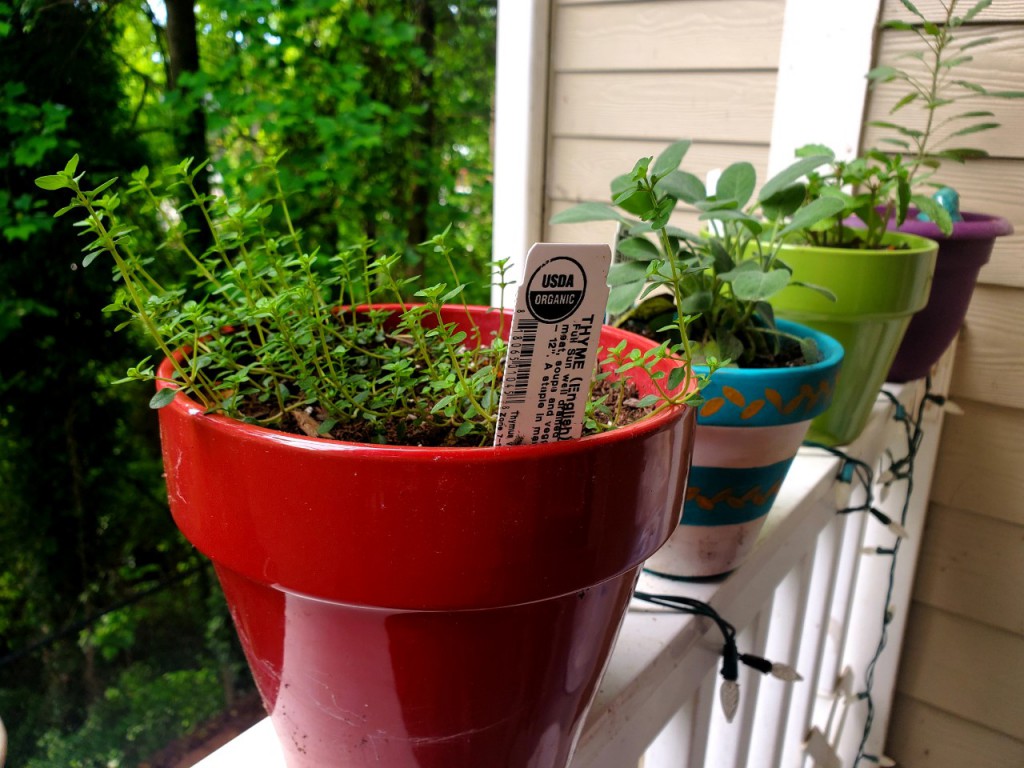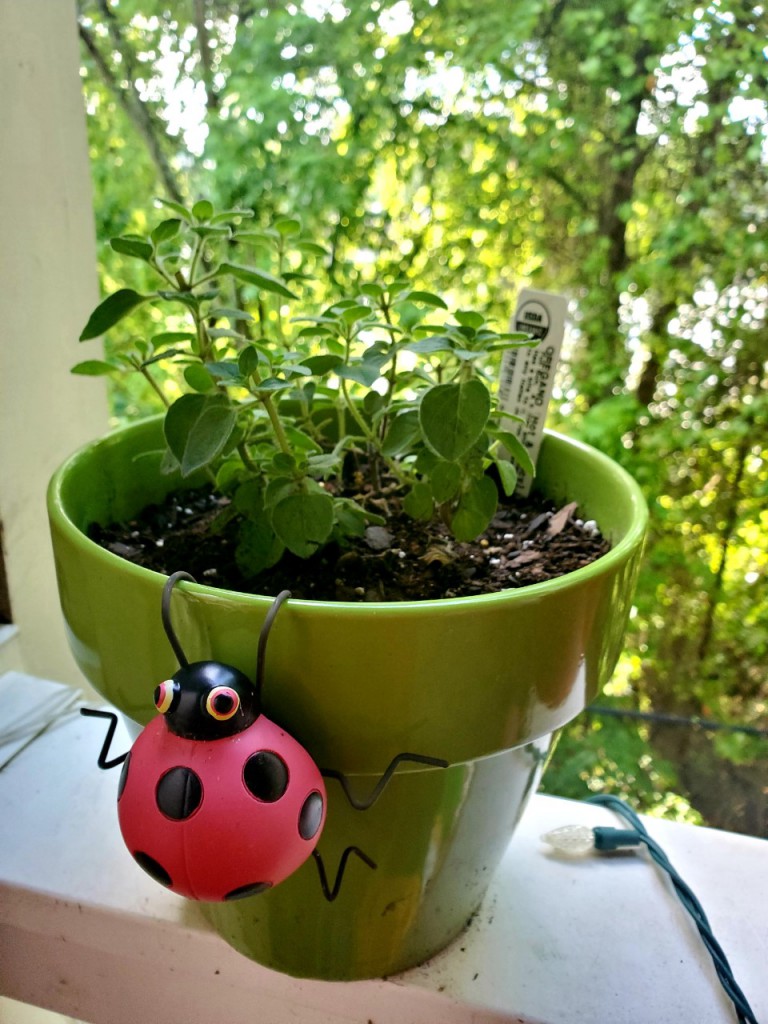
When you think of a thriving garden, you probably visualize a modest plot of land with rich soil, plants laden with juicy tomatoes and peppers, and bees busily buzzing to and from flowers scattered around. Well, if there’s one thing I’ve learned from urban living, it’s that sometimes that modest plot of land can be pretty hard to come by. However, that doesn’t mean that you can’t have pollinators buzzing and fresh vegetables and herbs right out your front door! Container gardening is a versatile way to produce fresh food in minimal space, and exercise a little creativity at the same time! Let’s go through the process.
SUNLIGHT
All plants require sunlight, often much more than you would think. Before you choose what to plant, get to know the light availability of your space and use it to your advantage. Vegetables need six to eight hours of sunlight to flower and set fruit, while many herbs can still produce several harvests with only four to six hours. Areas with south or west exposure will receive the most sunlight and are the best for plants like tomatoes, peppers, and cucumbers, while herbs can thrive with northern or eastern exposures. Knowing this, don’t be afraid to get creative! If you have a westward facing porch or balcony, you can trellis a squash plant up one side to provide a shady escape from the afternoon sun.
SOIL
If you are planting in containers, always use potting soil. This soil is not actually soil at all, but more of a compost with an ideal level of drainage. Some potting soils even contain additional fertilizers and nutrients that support your plant for up to six months. If you use one of these, do not add any other amendments until the available nutrition runs out. Avoid garden soil and seed starting mixes for transplants. Garden soil is heavier and does not drain well enough, leading to root rot and disease. Seed starting mix has the opposite problem: it drains much too quickly since it is meant for young seedlings sensitive to too much moisture.
CONTAINERS
The right container can make all the difference for your crop. Many ready-to-grow kits provide popular vegetables in one-gallon pots, but most plants need much more space. Tomatoes need at least five gallons, while annual herbs like basil and dill can thrive in a one- or two-gallon pot. Containers should always have some form of drainage to allow excess water to escape. This can be as simple as holes drilled into the bottom, or it can be as sophisticated as a built in self-watering mechanism. Pots and window boxes can also be a way to create visual interest. Planting containers come in all shapes, sizes and colors, so don’t be afraid to use them to brighten up your space. These bright colors can also attract beneficial insects and pollinators, so express yourself!
| Plant | Container Volume per plant |
| Tomatoes (determinate) | 5 gallons |
| Tomatoes (indeterminate) | 10 gallons |
| Bell Peppers | 2-3 gallons |
| Eggplant | 5 gallons |
| Beans | 2-3 gallons |
| Cucumbers and Squash | 10 gallons |
| Strawberries | 2-3 gallons |
| Annual herbs (basil, dill, cilantro, savory) | 1 gallon |
| Perennial herbs (sage, rosemary, lavender, mint) | 5 gallons |
WATERING
Fruits, vegetables, and herbs cannot survive long without water, especially in the Georgia summer heat. Depending on weather conditions, you may need to water every day, or you might be able to go several days without watering. Before you drench your plant, insert your finger about one and a half inches into the soil. If the soil is dry, it is time to water. If it is hot and sunny and you are going out of town for a few days, you can fill a narrow-necked glass bottle with water and insert the entire length of the neck into the soil. This will slow-release water for up to two days to give you some extra time between watering, and it offers a great re-use for those hard to recycle glass bottles!
PESTS AND PREDATORS
Gardening in containers can save you from a lot of diseases if your space is properly managed, but there’s one thing it can’t save you from: pests! In my own garden, I sometimes struggle with aphids and spider mites. Typically, pests are easily managed in nature by beneficial insects like lady beetles, lacewings and assassing bugs. However, if you’re gardening in an isolated area like a porch or balcony (or even a window box), that can be harder for these predators to find. You can bet that pests in large numbers won’t have any trouble finding it, though! When possible, avoid the use of pesticides and physically manage pests by squishing them, removing them, or smothering them with soapy water. Many container pests can also be resolved with horticultural oil.
PROBLEMS
Container gardening may be easier in the long run than managing an entire plot of land, but it doesn’t come without its challenges. Many container gardeners are so afraid of their plants drying up that they end up over-watering them. The problem with this is that over-watering and under-watering often have very similar symptoms: wilting, discolored leaves, stunted growth, and eventual plant death. Fungus gnats, tiny black flies, swarming around plants or crawling on soil are a major indicator of over-watering. If you allow the soil to dry out over one or two days and water less frequently, you will likely see improvement quickly.
Heat stress is also a challenge. Because plants are in containers, their roots are more easily exposed to temperature changes. Plants in black pots often wilt in hot weather as the container absorbs so much heat. However, if the plant is in the correct sized container, this problem will likely be avoided saved for the hottest of days.
Eventually, perennial plants may outgrow their original pots and require “up-potting”. If your plant is showing signs of stress such as new growth coming out of thick, woody stems at the bottom of the plant, or small and stunted leaves, it may be time to give it a bigger home. Choose a pot that is at about 50% larger than the current pot. Make sure to use fresh soil in the new pot so the plant has plenty of nutrients in its new space. Water thoroughly, and over the next few weeks you will see your plant grow larger than it ever has before!

For additional information on specific vegetables, visit extension.uga.edu and search for our Home Gardening Series, as well as the following publications:
Gardening in Containers (Circular 787)
Vegetable Planting Chart (Circular 963)
Starting Plants from Seed for the Home Gardener (Bulletin 1432)
Herbs in Southern Gardens (Bulletin 1170)